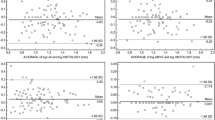Abstract
Purpose
This study was done to assess the feasibility of three-dimensional ultrasonography (3D-US) for volume calculation of solid breast lesions.
Materials and methods
The volumes of 36 malignant lesions were measured using conventional 2D-US, 3D-US and magnetic resonance imaging (MRI) and compared with that obtained with histology (standard of reference). With 2D Ultrasouns, volume was estimated by measuring three diameters and calculating volume with the mathematical formula for spheres. With 3D-US, stored images were retrieved and boundaries of masses were manually outlined; volume calculation was performed with VOCAL software. For MRI, volume measurements were obtained with special software for 3D reconstructions, after each lesion had been manually outlined. Histology measured the three main diameters and the volume was estimated using the mathematical formula for spheres. Interclass correlation coefficient (ICC) and Bland–Altman plots were used to assess agreement between the volumes measured.
Results
ICC indicated that a good level of concordance was identified between 3D-US and histology (0.79). According to the Bland–Altman analysis, limits of agreement of mean differences of the volumes measured with the three imaging modalities were comparable with histology: −2÷1.5 cm3 for 3D-US; −2.3÷1.3 cm3 for 2D-US and −2.2÷1.6 cm3 for MRI.
Conclusions
3D-US is a reliable method for the volumetric assessment of breast lesions. 3D-US is able to provide valuable information for the preoperative evaluation of lesions.








Similar content being viewed by others
References
Zonderland HM, Coerkamp EG, Hermans J et al (1999) Diagnosis of breast cancer: contribution of US as an adjunct to mammography. Radiology 213:413–422
Kolb TM, Lichy J, Newhouse JH (1998) Occult cancer in women with dense breasts: detection with screening US-diagnostic yield and tumor characteristics. Radiology 207:191–199
Weismann CF, Datz L (2007) Diagnostic algorithm: how to make use of new 2D, 3D and 4D ultrasound technologies in breast imaging. Eur J Radiol 64:250–257
Downey DB, Fenster A, Williams JC (2000) Clinical utility of three-dimensional US. Radiographics 20:559–571
de Sá Barreto EQ, Figuinha Milani HJ, Araujo Júnior E et al (2010) Reliability and validity of in vitro volume calculation by 3-dimensional ultrasonography using the multiplanar, virtual organ computer-aided analysis (VOCAL), and extended imaging VOCAL methods. J Ultrasound Med 29:767–774
Esserman L, Hylton N, Yassa L et al (1999) Utility of magnetic resonance imaging in the management of breast cancer: evidence for improved preoperative staging. J Clin Oncol 17:110–119
Londero V, Bazzocchi M, Del Frate C et al (2004) Locally advanced breast cancer: comparison of mammography, sonography and MR imaging in evaluation of residual disease in women receiving neoadjuvant chemotherapy. Eur Radiol 14:1371–1379
Lorenzon M, Zuiani C, Londero V et al (2009) Assessment of breast cancer response to neoadjuvant chemotherapy: is volumetric MRI a reliable tool? Eur J Radiol 71:82–88
D’Orsi CJ, Mendelson EB, Ikeda DM et al (2003) Breast imaging reporting and data system: ACR BI-RADS—Breast Imaging Atlas. American College of Radiology, Reston
Bland JM, Altman DG (1986) Statistical methods for assessing agreement between two methods of clinical measurement. Lancet 1:307–310
Rotten D, Levaillant JM, Zerat L (1999) Analysis of normal breast tissue and of solid breast masses using three-dimensional ultrasound mammography. Ultrasound Obstet Gynecol 14:114–124
Watermann DO, Foldi A, Beck Hanjalic et al (2005) Three-dimensional ultrasound for the assessment of breast lesions. Ultrasound Obstet Gynecol 25:592–598
Meyberg-Solomayer GC, Kraemer B, Bergmann A et al (2004) Does 3-D sonography bring any advantage to non-invasive breast diagnostics? Ultrasound Med Biol 30:583–589
Cho N, Moon WK, Cha JH et al (2006) Differentiating benign from malignant solid breast masses: comparison of two-dimensional and three-dimensional US. Radiology 240:26–32
Kim HC, Yang DM, Lee SH et al (2008) Usefulness of renal volume measurements obtained by a 3-dimensional sonographic transducer with matrix electronic arrays. J Ultrasound Med 27:1673–1681
Kim HC, Yang DM, Jin W et al (2010) Relation between total renal volume and renal function: usefulness of 3D sonographic measurements with matrix array transducer. AJR Am J Roentgenol 194:W186–W192
Ng E, Chen T, Lam R et al (2004) Three dimensional ultrasound measurement of thyroid volume in asymptomatic male Chinese. Ultrasound Med Biol 30:1427–1433
Ying M, Sin M, Pang S (2005) Sonographic measurement of thyroid gland volume: a comparison of 2D and 3D ultrasound. Radiography 11:242–248
Lang H, Wolf GK, Prokop M et al (1999) 3-Dimensional sonography for volume determination of liver tumors—report of initial experiences. Der Chirurg 70(3):246–250
Pang BSF, Kot BCW, Ying M (2006) Three-dimensional ultrasound volumetric measurements: is the largest number of image planes necessary for outlining the region-of-interest? Ultrasound Med Biol 32:1193–1202
Rominger MB, Fournell D, Nadar BT et al (2009) Accuracy of MRI volume measurements of breast lesions: comparison between automated, semiautomated and manual assessment. Eur Radiol 19:1097–1107
Kotsianos-Hermle D, Hiltawsky KM, Wirth S et al (2009) Analysis of 107 breast lesions with automated 3D ultrasound and comparison with mammography and manual ultrasound. Eur J Radiol 71:109–115
Levrini G, Sghedoni R, Mori C et al (2011) Size assessment of breast lesions by means of a computer-aided detection (CAD) system for magnetic resonance mammography. Radiol Med 116:1039–1049
Wiesmann CF, Forstner R, Prokop E et al (2000) Three-dimensional targeting: a new three-dimensional ultrasound technique to evaluate needle position during breast biopsy. Ultrasound Obstet Gynecol 16:359–364
Delle Chiaie L, Terinde R (2004) Three-dimensional ultrasound-validated large-core needle biopsy: is it a reliable method for the histological assessment of breast lesions? Ultrasound Obstet Gynecol 23:393–397
Sahiner B, Chan HP, Roubidoux MA et al (2007) Malignant and benign breast masses on 3D US volumetric images: effect of computer-aided diagnosis on radiologist accuracy. Radiology 242:716–724
Conflict of interest
Paola Clauser, Viviana Londero, Giuseppe Como, Rossano Girometti, Massimo Bazzocchi, Chiara Zuiani declare no conflict of interest.
Author information
Authors and Affiliations
Corresponding author
Rights and permissions
About this article
Cite this article
Clauser, P., Londero, V., Como, G. et al. Comparison between different imaging techniques in the evaluation of malignant breast lesions: can 3D ultrasound be useful?. Radiol med 119, 240–248 (2014). https://doi.org/10.1007/s11547-013-0338-z
Received:
Accepted:
Published:
Issue Date:
DOI: https://doi.org/10.1007/s11547-013-0338-z




